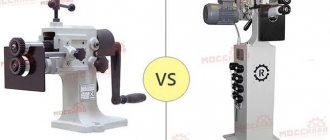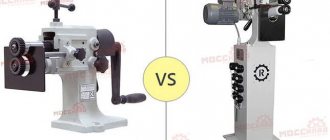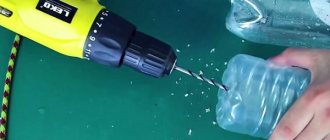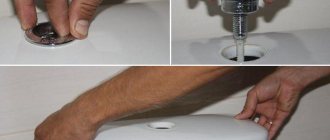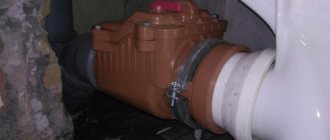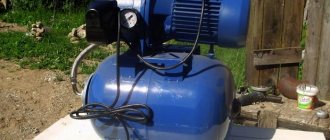Impact crusher device
Loading and unloading of material occurs through pneumatic hoses: one sucks the material inside, and the other blows out crushed particles and delivers them to the raw material hopper.
The central element of the crushing chamber is the rotor
- a rotating device based on a shaft on which beaters are attached - hammers that strike the crushed material. There is a sieve around the rotor.
When material enters the chamber, it is broken up by the rotating beaters of the rotor. Crushing occurs until the fraction passes through the installed sieve.
Buy a rotary grain crusher from the manufacturer
Manufacturing company ALB Group produces DRP impact crushers
for feed production. We produce a wide range of reliable shredders that can be selected exactly for the volume of products you plan to produce.
Why is it worth buying a rotary grain crusher from ALB Group?
One of the features is the use of a powerful neodymium magnet
to clean the mass from metal impurities.
Laser cutting of parts
ensures ideal geometry of crushing equipment. This parameter is important for the durability of the device, since the rotor moves at a high angular speed and is subject to heavy loads.
The power of our units varies from 7.5 to 37 kW
.
Fast and timely delivery of spare parts
. We are located in Nizhny Novgorod, and promptly deliver parts for our equipment. This ensures there are no interruptions in production.
Order an impact crusher from ALB Group by phone +7
or in the contact form. We will answer all your questions and select exactly the crusher that is best suited for your production.
Complete set of impact crusher manufactured by ALB Group:
In addition to the crusher itself, the package includes:
- elastic intake hose, the length of which can vary from 7.5 to 10 meters and, depending on the crusher model, with a diameter of 75 to 125 mm;
- intake device (ejector);
- elastic pressure hose, the length of which can vary from 4 to 6 meters and, depending on the crusher model, with a diameter of 75 to 125 mm;
- hose clamps;
- 3 spare sieves;
- set of replacement hammers;
- crusher operating manual.
© 2017
Russian manufacturer and supplier of equipment for the production of pellets and mixed feed
603141, Nizhny Novgorod, st. Larina, 12, office 318
115191, Russia, Moscow, Dukhovskoy lane, 17, office 12A
Every owner of a homestead farm must constantly take care of his farm. To increase the return on farming, small-scale mechanization tools are used. One of these means is a grain crusher. Its main task is to grind grain to obtain feed for the animals on the farm.
As a result of the operation of this equipment, the shell is removed from the grains, which cannot always be penetrated by the digestive juices of animals. The food obtained after such processing becomes more nutritious and healthier. After eating such food, animals experience growth, etc.
Specifications and prices
The Bumblebee grain crusher has an engine power of 11 kilowatts , which reaches speeds of up to 3,000 rpm. It is capable of grinding 2-3 tons of grain per hour, depending on its density and feed speed, but such high productivity is ensured by a three-phase 380 volt line.
This grain crusher is universal - it is capable of grinding not only grain, but also wood - pine needles, birch bark and the like. It also copes well with “dead” waste, hay and reeds - they can be ground to the consistency of cotton wool and added to animal feed.
"Bumblebee" is very reliable. Equally reliable grain crushers include Zubr, Khryusha, Cyclone, and Kolos.
The service life of the crusher rotor is about 2,000 tons, the service life of the hammer knives is approximately 60 tons for each corner, so they will have to be changed no more often than once per 200 tons of ground raw materials.
“Bumblebee”, in fact, is the only grain crusher that does not require any additional devices for operation - its movement around a warehouse or granary is carried out thanks to built-in rollers, on which it can be transported anywhere.
This is one of the main features of the “Bumblebee” - complete mobility, which is limited only by the length of the power cable. The installation, moreover, can work on any site, even open.
The installation can operate on any area, and in this case there will be no need to use any special tools in order to deliver grain or other product to the receiver. To do this, “Bumblebee” can be transported in the desired direction.
Also, to facilitate the collection of cereals, the design of the crusher includes a collection device , which is supplied in the kit. With its help, you can simply collect grain directly from the storage location. This is possible thanks to the vacuum that occurs during crushing.
The cost of this grain crusher averages 170,000 rubles, fully equipped.
And considering all the advantages that the Shmel grain crusher has, the price is not that high, especially if you compare it with the prices of similar products not only from foreign, but also from domestic manufacturers.
The delivery set includes the grain crusher itself with a suction device, three sieves with different diameters - 4 mm, 6 mm and 8 mm, a starting device, a cable 10 meters long, a reinforced corrugated hose "Lignum" 3 meters long, a bag filler equipped with rollers for ease of movement, with fabric filter.
An adapter for the hose and a loading hopper designed for hay and straw to obtain flour from them are also additionally
Types of home grain crushers, classification of units
Almost all feed produced for livestock is not in a very convenient form and is often difficult to digest by animals living in the barnyard.
To improve digestion, it is advisable to pre-process the feed. That is, pass it through a crusher (grinder) and the sieve that is installed in it.
This approach allows you to add various food additives, vitamins and other components included in the livestock diet to the crushed feed. When introducing additives, the resulting mixture must be thoroughly mixed.
Here it must be said that livestock and poultry gladly accept such food and this has a positive effect on their weight.
The possibility of obtaining nutrition for livestock in this form significantly increases the efficiency of feed use.
Features of Cone Crusher
The operating principle of the presented device is slightly different. That is, it has its own characteristics. For example, a cone crusher crushes raw materials using two truncated cones. When they rotate, the raw materials fall between their walls and are crushed. As you can see, there are no hammers here. The movable shaft is fixed in an eccentric sleeve.
As in the previous case, a cone crusher can crush almost any raw material that is not highly viscous. Quite often, such a unit is used for crushing very hard rocks. In this case, the fraction of the resulting material can be completely different.
Types of crushers
Crushers can be divided into several classes:
- Industrial - they are used in large agro-industrial farms.
- Household - they have found their application in household plots.
Another classification option can be given.
The numerous range of crushers can be classified as follows - according to the type of feed processed:
- Plants for root processing. It is used for cutting root vegetables and further mixing with food additives and vitamins.
- Silage processing plants - this equipment is used for crushing grain sprouts, grass or malt.
Operating principle of crushers
The main operating principle of the shredder is as follows: under the influence of the mechanisms included in this equipment, the original product is destroyed. Then, the resulting semi-finished product is sorted using a sieve. This device helps sort the resulting particles by size. The fraction of the resulting particles is called the grinding size.
Hammers or knives can be used as working tools. Which rotate at high speed inside the container into which the raw materials to be processed are poured. In fact, a hammer grinder resembles a device such as a tumbling machine, which is widely used in mechanical engineering.
The working bodies can be set in motion either by muscular force or by electric drive. The use of small-sized crushers, which are often used in household plots, significantly facilitates work and increases labor productivity. On large farms or agricultural complexes it is impossible to do without industrial installations. As such a unit, you can consider a “bumblebee” grain crusher. This domestic development has found wide application in small farms and household plots.
The crushing mechanism installed in this product allows you to process not only feed, but also process certain materials, such as mica, which is used as additives.
Those who know how to handle a tool and a welding machine can easily complete a crushing plant with their own hands.
Operating principle and purpose of hammer crushers
Hammer crushers are currently used for coarse, medium and fine crushing.
These crushers are not complex in design, simple and reliable in operation, small in size and have high productivity with a relatively high degree of grinding. Hammer crushers include impact crushers with impact elements hinged on the rotor - hammers. Hammer crushers are characterized by a high degree of crushing, reaching 100, as well as low weight and low cost per 1 ton of processed material. The power consumption, weight and dimensions of a hammer crusher per unit of productivity are 2 - 5 times less than those of jaw and cone crushers. The relatively small size of hammer crushers allows them to be installed in confined spaces, such as mines. The tightness of the housing and the possibility of tightly connecting the loading and unloading chutes make it possible to prevent the release of dust into the environment at low aspiration costs. Most hammer crushers have low sensitivity to the entry of non-crushable objects into the crushing chamber. It should be noted such advantages of hammer crushers as simplicity of design and ease of maintenance and repair. Convenience and speed of repair and maintenance are ensured by ease of access to the inside of the crusher due to the presence of doors or the use of a hydraulic housing opening system. Installation of a hammer crusher with a dynamically balanced rotor does not require the construction of a heavy foundation.
Impact crushers are used mainly for grinding low-abrasive materials of medium strength (limestone, dolomite, marl, coal, rock salt, etc.). In some cases, due to the technological features of production, impact crushers are also used when processing materials with increased strength and abrasiveness (for example, asbestos ores, slag, etc.).
Until recently, due to the relatively rapid wear of hammers, armor plates, grates and other internal parts, as well as the possibility of coating the grates, low utilization rates and high operating costs, the scope of application of these crushers was limited. Recently, as a result of improving their design, using wear-resistant materials, simplifying manufacturing methods and replacing wear parts, they are becoming increasingly widespread.
Currently, hammer crushers are widely used in various branches of the building materials industry. In the cement industry, hammer crushers are used for preliminary crushing of clay, limestone, marl and chalk - the main components of cement. Hammer crushers are used for fine grinding of gypsum and other additives to cement clinker. Hammer crushers are used to equip grate coolers for crushing sintered pieces of cement clinker. In the asbestos industry, hammer crushers, which are widely used, are effectively used for crushing and fluffing asbestos ore. Crushers allow this operation to be carried out in 3-4 stages.
Hammer crushers are used to produce finely dispersed carbonate raw materials used for the production of glass, filler in plastics, as well as for the production of dolomite and limestone flour.
In the production of building bricks, hammer crushers are used to crush broken bricks, coal, and dry clay. When producing sand-lime bricks, instead of ball mills, hammer crushers are installed to finely crush lime after it is fired in shaft kilns.
In the production of gypsum, hammer crushers are used for primary and fine crushing of gypsum stone. In addition, hammer crushers are used for processing mica and mica scrap, in the extraction and processing of rock salt, phosphates, saltpeter, and soda. In the coal industry, they are used for crushing coal that has grown together with waste rock. In thermal power engineering, hammer crushers are used for fine grinding of coal used as fuel.
In impact crushers, the crushed material is destroyed under the action of mechanical impact, in which the kinetic energy of moving bodies is completely or partially converted into the energy of deformation and destruction.
Unlike other crushers, which compress a piece between two crushing surfaces, in impact crushers the piece of material is usually impacted from only one side, and the resulting crushing forces are determined by the inertial forces of the mass of the piece itself.
The material to be crushed is loaded into the crusher from above. Under the influence of gravity, it falls or slides along the tray and is hit by the hammers of a rapidly rotating rotor. As a result of a blow with a hammer, the piece is destroyed, its fragments scatter and are thrown onto the lining - impact plates or grates that form the crushing chamber. Hitting the lining, the material is further crushed and, being reflected, again falls under the action of the rotor. This is repeated many times until the pieces of material, having reached a certain size, come out through the unloading slot or the grate slot for unloading.
In some cases, a piece of material, having received an eccentric impact, begins to rotate around its center of mass at a speed close to the speed of the crusher working body (approximately 30 m/s). And it collapses, since in this case, due to the action of centrifugal forces, a stress of about 10 MPa arises in a piece of material, which exceeds the tensile strength of many rocks.
Thus, in impact crushers, the material is crushed as a result of an impact on a rapidly moving working element, the collision of pieces against one another, an impact on the stationary lining of the crushing chamber, and also under the influence of centrifugal forces.
The hammer crusher has a welded body (made of sheet steel or cast iron).
Which grain crusher is better: hammer or rotary?
In practice, crushers are used, which are based on two basic concepts - rotary and hammer.
Impact crushers
The first type is heavy, large, and requires a fairly powerful electric motor to operate. This device easily processes different types of crops - grains, herbs and root vegetables.
The working part of such a machine is a rotor with knives fixed on it.
The dimensions of the crushed raw materials directly depend on the rotor rotation speed. This equipment costs significantly more than hammer equipment. In addition, due to the large overall dimensions and weight parameters, these installations are used mostly on large farms.
Hammer crushers
This type of crusher has a more complex design. But this does not cause any difficulties in operation.
The hammer type includes:
- frame;
- hammers;
- container into which raw materials are poured;
- drum;
- sieve;
- power point.
After the power plant starts, the drum begins to rotate, and the hammers located inside it begin to hit it from the inside.
The grain that gets inside the drum splits under the impact and after some time reaches the specified size.
In fact, there is no clear answer to the question of which crusher is better. Everything is determined by the size of the farm or personal plot and, of course, the requirements for feed.
In addition, a rotary machine can process the same volume of raw materials faster than a hammer machine, but the quality of the resulting product is better with a hammer machine.
Types of grain grinding machines
Types of machines for grinding grain
Depending on the grinding method, design and location of the working parts, there are 4 types of grain crushers:
- Rotary – crushing of grain in such devices occurs due to a rotor located horizontally and moving at high speed.
- Hammer crushers - the design of such grain crushers includes a rotating vertical drum and stationary hammers located in a circle, against which the grain is crushed. When grinding in this way, the finished flour is poured down and, passing through a sieve, ends up in a container placed under the deck of the housing.
- Roller crushers crush grain due to 2 rollers located in one chamber, rotating towards each other. At the same time, the gap between them is so small that the incoming raw material is not simply crushed, but, due to high speed, is crushed into dust. The advantage of such devices over others is the ability to crush grain with high humidity.
- Millstones are grain crushers in which grain is crushed when it gets between two discs (millstones) located with a small gap. In this case, one disk rotates at high speed, and the second is stationary.
Be sure to read:
We assemble an electric shepherd with our own hands: operation diagram, number and height of lines
Among these varieties, the most common are rotary and hammer ones - they are more productive, reliable, and easier to repair and maintain.
Structure of a grain crusher, design features of the machine
Manufacturers put a variety of crushers on the market, with different characteristics, productivity, etc. Most of this equipment is easy to maintain and does not take up much space. As noted above, in practice crushers are used that use rotary or hammer principles in their operation.
Rotary machines have a drum with knives. In hammer mills, hammers are used as a working tool, which are loaded inside the drum.
By the way, there is equipment that uses compressed air as an energy source. The processed raw material moves inside the drum along with air. As a result of this, the quality of the resulting product increases dramatically. In addition, in this, and in many other designs, magnets are used that select metal particles that get into the mixture.
Popular crusher models
These devices are manufactured by different companies and have different characteristics, but their main distinguishing feature is the principle of operation and methods of their use. Below are some of the most popular types of shredders.
Crusher Molot – 400
The hammer crusher of the Molot - 400 series is designed for grinding dry materials. The Hammer 400 crusher is used in cooking (crushes sugar, spices, caramel), agriculture (grain, peas, rice), construction (slag, gypsum) and other industries.
Hammer crusher Molot 400
- convenient sieve change;
- low noise;
- low level of wear of parts.
Hammer feed crusher DKM - 5
The DKM-5 crusher is designed for grinding feed and mineral additives.
Widely used in agriculture to supply livestock farms. The device can operate in three modes: automatic, manual and adjustment.
- simple design;
- easy installation;
- long service life;
- low energy consumption.
Wood waste shredder
The principle of operation is to grind wood waste. It is very popular in the sawmill and logging industry. Suitable for wood chips, wood, as well as branches, large twigs, etc. Allows the production of various materials: shavings, sawdust, wood dust. Used to avoid costs associated with the disposal of wood waste. In addition, the finished product can be used for further sale.
Multifunctional shredder (crusher) of wood waste and recyclable materials DU-2
The operating principle of the wood shredder and the functioning of the device are based on the principle of shredding wood waste, which takes place in several stages:
- purification of raw materials from foreign materials and transportation to the main production;
- grinding of raw materials;
- formation of the resulting product into fractions, removal of particles that do not correspond to general parameters;
- formation of finished products.
How to choose a grain crusher: expert advice
Choosing the right model
How should you choose a crusher that will meet all consumer requirements? To do this, you need to know the answers to some questions:
- Performance. A high grinding speed ensures high productivity in obtaining finished products, and accordingly, the use of such an installation will be highly efficient. Such installations can be considered the optimal solution for large farms. For home work, an installation with a low or medium processing speed of raw materials is sufficient.
- Price. The equipment must not only ensure high quality of the resulting product, but also generate certain income to recoup the investments made in this equipment.
- Grinding degree. The device must be selected based on the type of livestock and poultry the produced feed will be intended for.
- Drive station power. The greater the power of the installed power plant, the greater the productivity of the installation. It must be taken into account that the higher the engine power, the higher the energy costs.
- The company is a manufacturer. Undoubtedly, there are world-famous companies that produce shredders, but you need to think three times about how quickly the funds invested in brands will pay off.
When choosing a model, you must be guided by the characteristics specified by the manufacturer.
Rating of grain crushers by quality
There are a wide variety of shredders on the market, many of which are popular for their reliability and performance. We have compiled the TOP 5 grain crushers that are most often used in various private farms. Our rating includes:
- 5th place – Farmer. This model differs from most market analogues in its extremely high strength and durability. Maximum simplicity of design, minimum plastic parts and increased engine power - all this allows the chopper to serve for 5 years or more;
- 4th place – Cyclone IZKB-2. This modification is capable of processing not only different types of grains, but also prepared root vegetables. The crusher equipment includes a durable 1.8 kW electric motor, a knife drum and a reliable metal body;
- 3rd place – Clever Don . This chopper differs from its analogues in its increased power, which allows it to produce up to 200 kg of flour in just an hour of operation. The crusher is equipped with 3 sieves designed to adjust the grinding amount;
- 2nd place – Zubr-2. One of the most popular grinders is designed for use in small and medium-sized animal farms. The unit is equipped with a reliable electric motor, two replaceable sieves and a durable lock;
- 1st place – Zubrenok-Mais. The productivity of this unit is 140 kg of grain per 1 hour of operation. This is much more than any Chinese crusher can grind.
Our review included only household crushers from the low and medium price segment. Despite their modest size, each of them demonstrates maximum performance and impressive efficiency.
DIY grain crusher
A grain crusher is not the most complex structure and its need for use in household plots and farms has already been proven many times. But it should be noted that this is for the cheapest installations. Therefore, those who need this equipment make it themselves. In fact, it is not that difficult, and does not require a large set of tools.
DIY grain crusher
Making the base of the chopper The base of the chopper includes the following components:
- Flange;
- The hub on which the bearing assembly is installed;
- Toothed drum;
- Flange support;
- Flange mounted on drum;
- Power plant;
- Sieve plates;
- Arcs;
- Corner 45x45;
- Grain funnel;
- Fasteners.
Crusher balancing process
Most equipment that uses rotating components as a working tool undergoes a balancing procedure. This work can be done either independently or with the help of invited specialists.
When balancing, the following sets of work must be performed:
- identifying the causes of vibrations and eliminating them;
- monitoring the condition of equipment in terms of vibration;
- balancing shafts in existing bearings;
Why is balancing necessary? The answer lies on the surface. The thing is that the presence of excessive vibration leads to failure of the bearing units, and as a result, everything can end very sadly.
Grinder grinder
An angle grinder is a frequently used item in any household. Folk craftsmen figured out how to expand its capabilities. From it, with minor modifications, you can make a grain crusher with your own hands. Moreover, this event does not require any special expenses.
Do-it-yourself grain crusher from a grinder
The basis of such a structure can be a sheet of durable plywood; the components of the structure will be attached to it. Instead of plywood, it is permissible to use laminate. Two holes are made in the sheet into which they will be installed - the saw body and the grain receiving hopper.
To secure the grinding machine, staples and bolts are used. A metal disk with mutual sharpening is used as a crusher. This will be the grain crushing plant.
A mesh with the appropriate mesh size must be secured to the bottom of the sheet. You can purchase a ready-made mesh (sieve), or you can use a kitchen colander.
A plastic bottle with a capacity of five liters can become a grain bin. That's it, the homemade crusher is ready for use.
Common types of crushers
Over the long period during which home craftsmen have been producing homemade grain crushers, all sorts of designs have been developed, differing in the principle of operation and basic components. Each model had both its advantages and disadvantages. Self-made units can be upgraded, repaired or simplified if necessary at any time without any problems.
Homemade grain grinder
Centrifugal type
The main working process inside this design is reminiscent of the operation of a popular electric coffee grinder. The crushing process is carried out by several knives located on the walls of the cavity. The grain is pushed towards them due to centrifugal rotation. Adjustment of the resulting fraction is ensured by sieves with different cell diameters. Productivity depends on the sharpness of the knives and the power of the connected motor.
Screw type
Appliances used for household purposes are sometimes called screw ones. Inside, the grains are cut and flattened. This is facilitated by a splined block and a metal polyhedron. The disadvantage is the rapid dulling of the edges of the latter, after which productivity drops and there is no possibility of adjusting the fraction.
Installations with screws are more advantageous. They are combined, since a cutting bar is used in combination with the auger. Such a homemade grain crusher is quite common in the private sector.
Diagram of a homemade grain crusher
Mill type
Very often, do-it-yourself grain crushers of this type are made, because diagrams and drawings for them are widespread and accessible. The design can be called one of the ancient ones, since stone millstones worked on this principle. The disadvantage of this work is the inability to adjust the size of the resulting fraction.
Rolling type
Photos of the manufacturing process will be in many ways similar to the production of a screw apparatus. However, a different number of teeth can be positioned on a polyhedron. The design allows you to easily adjust the grinding density. By replacing the shaft with a round grater, you will be able to obtain a product of the required size.
VIDEO: How to make a crumble in just 2 hours
Homemade grain crusher from an angle grinder
This model is one of the simplest and lowest-cost grain crushing devices. The versatility of the grinder design allows it to be used to help make food for domestic animals. For such a homemade product, you don’t even need drawings, since a minimum of components is used.
Coarse grinder from an angle grinder. To reduce dust in the room, be sure to use a tight-fitting lid
You will need a strong plywood strip, which will become the base of the structure. The remaining elements will be hung on it. Some users use a piece of laminate instead. Two holes are cut in the sheet:
- the first for the saw body;
- the second is for attaching the receiving hopper.
Self-tapping screws and staples are used for fixation to the body. A knife with double-sided sharpening is placed on a rotating shaft. It is the main cutting element. It is customary to fix a grid of optimal geometric parameters with bolts on the underside of the plywood.
The mesh is made from an old aluminum pan, which is drilled with many holes. An old metal colander is also used for this purpose. The hopper in this model is usually a prepared five-liter plastic bottle.
Grain crusher from a washing machine
A model made from a washing machine motor has high productivity. This is facilitated by an optimal design that can be easily converted for cereal cutting. The preference in this situation is Soviet models with a cylindrical stainless steel tank and a lower engine.
Example of a mill with V-belt drive
In some cases, the system is supplemented with a second motor. Installation is carried out at the top, under the cover.
The motor from the washing machine is placed on a corner or channels. The cutting element is a two-bladed knife with double sharpening, located on the drive shaft. Its length should be such as to come as close as possible to the inner walls, but not touch them. The second knife is mounted on the lower motor and is rotated in the opposite direction. With such an arrangement it will be possible to create maximum performance.
Since you need to feed grain into the assembled grain crusher with your own hands, we make a hole in the top lid with a small funnel. This way, falling asleep will be done with minimal losses and with convenience. Any plastic container without a bottom and a large neck is suitable for this element.
It is important to protect the motor from aggressive environments. Traditionally, a plastic dust cover is made for this purpose. A paint can will work for this. We make a hole near the lower slider through which the crushed grain is removed.
The operating principle of such a unit becomes clear even from a schematic sketch. Everything works like a classic coffee grinder. It is especially important to have multi-directional knives. The positive qualities of the design are the following factors:
- high productivity;
- fine grinding;
- ease of assembly;
- availability of materials;
- easy customization;
- long-term operation.
It is important to understand the principle of operation, how to assemble everything yourself; the drawings will be individual in such a situation.
VIDEO: Grain crusher from a washing machine centrifuge engine
How to make a grain crusher from a vacuum cleaner
Craftsmen make designs even from old models of vacuum cleaners. The engine is removed from household accessories and adapted for threshing. In an economical version, a cut-out sheet of plywood with a hole in the center is suitable for a do-it-yourself grain crusher. The end of the rotor shaft from the electric motor passes through the center of the hole.
Mill from an old vacuum cleaner
A metal plate prepared in a special way is used as knives:
- the length is cut to such an extent that the edge comes as close as possible to the inner surface of the working cavity;
- edges are sharpened on both sides;
- For fixation on the shaft, a central hole is made.
The most comfortable length is 150-200 mm. For better performance, knives are made from a vegetable cutting disc. For fastening to the shaft, use nuts or bolts with lock washers.
The working cavity is a sieve or perforated cavity. It is advisable to design a dismountable, repairable system with removable parts.
Any large container is used as a bunker for finished products. The grain is fed through a mounted chute with a valve that helps dispense portions.
VIDEO: Kruporushka from a vacuum cleaner
Grain crusher from a washing machine
Krurushka can be made using an old washing machine. The principle of its operation will be similar to the operation of a coffee grinder. That is, the original product will be crushed using knives that rotate inside the drum. Washing machines, for the most part, have different designs and therefore it is important to understand the very principle of operation of the shredder based on it.
DIY grain crusher from a washing machine
The first engine must be installed at the bottom of the machine tank. A mesh is also installed there and a window is made through which the finished product will come out.
Another motor is installed at the inlet, near the base. To protect the unit from dust, a protective cover can be installed on this structure.
The motor shafts must rotate in different directions. Experience shows that the optimal solution is to install them at an angle of 25 degrees.
The size of the hopper through which the feedstock will be supplied to the crusher. Again, experience shows that shredders assembled on the base of a washing machine have high productivity, and therefore it makes sense to install a shield gate on the hopper.
The ground grain must go into a container, which must be installed under the assembled installation. To increase the comfort of work, it makes sense to install a sleeve on the exit hatch, which will prevent the finished product from scattering to the side.
What malfunctions can occur and how can they be eliminated?
Naturally, despite all the advantages of this product, it may fail from time to time. There can be many reasons for this: poor quality assembly, improper use and others. You may encounter the following problems:
1. Crusher vibration. Moreover, it can be detected not only during operation, but also at the startup stage. In this case, the cause may be incorrectly selected hammers in weight or an imbalance in their balancing (element failure). Repairing a hammer crusher in this case is very simple. You need to replace the hammers or balance them.
2. Low level of productivity. This problem may be due to improper supply of raw materials, as well as a clogged grate. To eliminate the malfunction, you simply need to adjust the supply of material, as well as clean the cracks through which the finished mixture is sifted into the container. In addition, pay attention to the moisture level of the raw materials.
3. Knock in the device. This problem can be caused by a foreign object that cannot be crushed, as well as poor-quality fixation of the mechanism elements. In this case, check the fastening of the grille or hammers, linings. You also need to clean the camera of unnecessary materials.
4. Excessive heating of bearings. This happens when the elements are not well lubricated. Heat can also occur when bearings fail. If they are intact, then they need to be re-lubricated with clean and high-quality oil. If not, then the bearings need to be changed.
5. Incorrect fraction of the output material (fraction too large). In this case, the grille may be broken or incorrectly selected. Naturally, this part will have to be changed. It's not that difficult to do.
As you can see, any technical device requires proper operation and careful care. Try to periodically check the mobility of the crusher elements and the quality of their lubrication. If the breakdown is more serious, then it is better to entrust the repair of the product to a specialist. Good luck!
Grain crusher from a vacuum cleaner
A homemade crusher can also be assembled from a vacuum cleaner.
To perform this task with your own hands, the vacuum cleaner itself is not particularly needed. Just the engine is enough. The sequence of making a shredder with your own hands is as follows.
To form the base, you can use laminate or plywood.
DIY grain crusher from a vacuum cleaner
In its center it is necessary to form a hole for installing the engine.
To make working knives with your own hands, it is permissible to use a steel plate. A width of up to 20 cm and a thickness of 1.5 - 2 mm can be considered optimal.
The knife must be fixed on the motor shaft.
You can use a kitchen sieve as a working chamber.
It is necessary to install a bunker under the sieve, where the finished product will be sent. A plastic bottle can play the role of a bunker.
Making a homemade grain crusher.
For the grain crusher, you can use a water pump engine with a power of about 1.5 kW 3000 rpm.
The engine is installed on a base, a metal sheet with a thickness of at least 3 mm. You need to drill a hole in the sheet with a diameter slightly larger than the diameter of the motor shaft. We fasten the engine to the plate with bolts.
The working chamber can be made from 3 mm sheet metal, cut out a strip 40 mm thick and bend a ring with a diameter of 300 mm from it. The ring is welded to the base.
To attach the knife to the motor shaft, you will need a coupling; you can order the coupling to be turned by any turner.
A grain crusher blade can be made from a lawn mower blade or a circular saw blade. The length of the knife should be accordingly 10 - 20 mm less than the diameter of the working chamber. The knife is attached to the coupling with M 8 bolts, the coupling is placed on the motor shaft.
We close the bottom of the working chamber with a sieve; the sieve can be made from a metal mesh with a hole size of 3 - 3.5 mm. We attach the sieve to the working chamber with studs and nuts; if you need to change the grind size, just change the sieve to another one with holes of the required diameter.
Installation of a bunker for filling grain. You can use any cone-shaped container for the hopper; to do this, you need to make a small hole with a diameter of about 30 mm in the upper plate of the working chamber, weld the hopper onto it and make a valve to regulate the flow of grain from the hopper to the chamber.
We install the grain crusher on a metal barrel or other suitable container.
How to make a crusher mill with your own hands
Making a grain crusher with your own hands is not that difficult. To do this, you need to have on hand a motor from an old household appliance, for example, a vacuum cleaner or washing machine.
DIY crusher mill
In addition, you must have some locksmith skills. By the way, when assembling such equipment with your own hands, you need to remember the safety rules. Since all engines operate on electricity, it is necessary to take all measures to reduce the traumatic risk of the assembled product. We must not forget that fast-rotating parts are used as a working body, which can cause injury to the person working on it.
Raw materials and finished product
Grain crushers, often called grain grinders, grinders, etc., are used to produce feed mass in a home or farm environment.
Grain and root crops are used as raw materials to obtain finished feed. You need to understand that the same devices can be used to process grain and root crops, but sometimes it is necessary to re-adjust the grain crusher.
When making a grain crusher with your own hands, you must remember that after processing on the grinder you can produce feed pellets of different sizes, some of which will be suitable for cattle, others for poultry. The installation parameters and dimensions of crushing devices (knives, hammers, drums) must be selected accordingly.
After receiving the crushed product, food additives, vitamins and other components necessary to obtain a complete feed are mixed into it.
If you find an error, please select a piece of text and press Ctrl+Enter.




